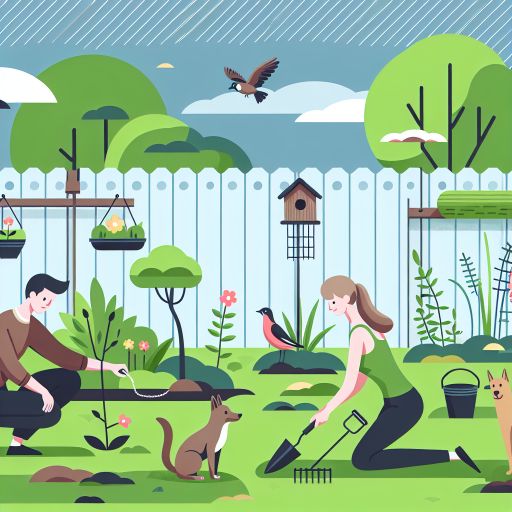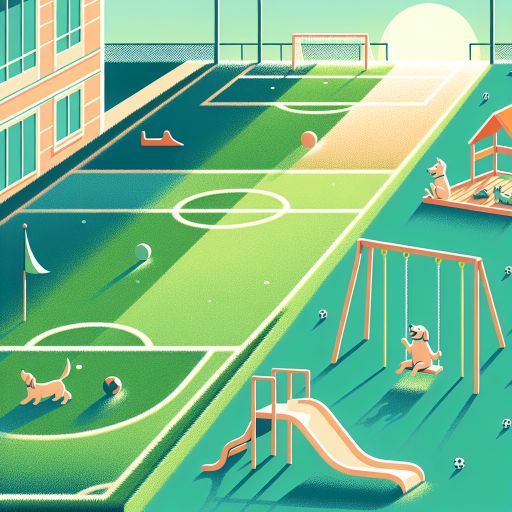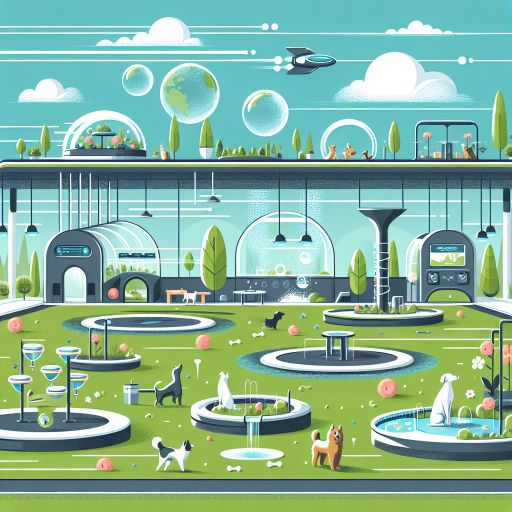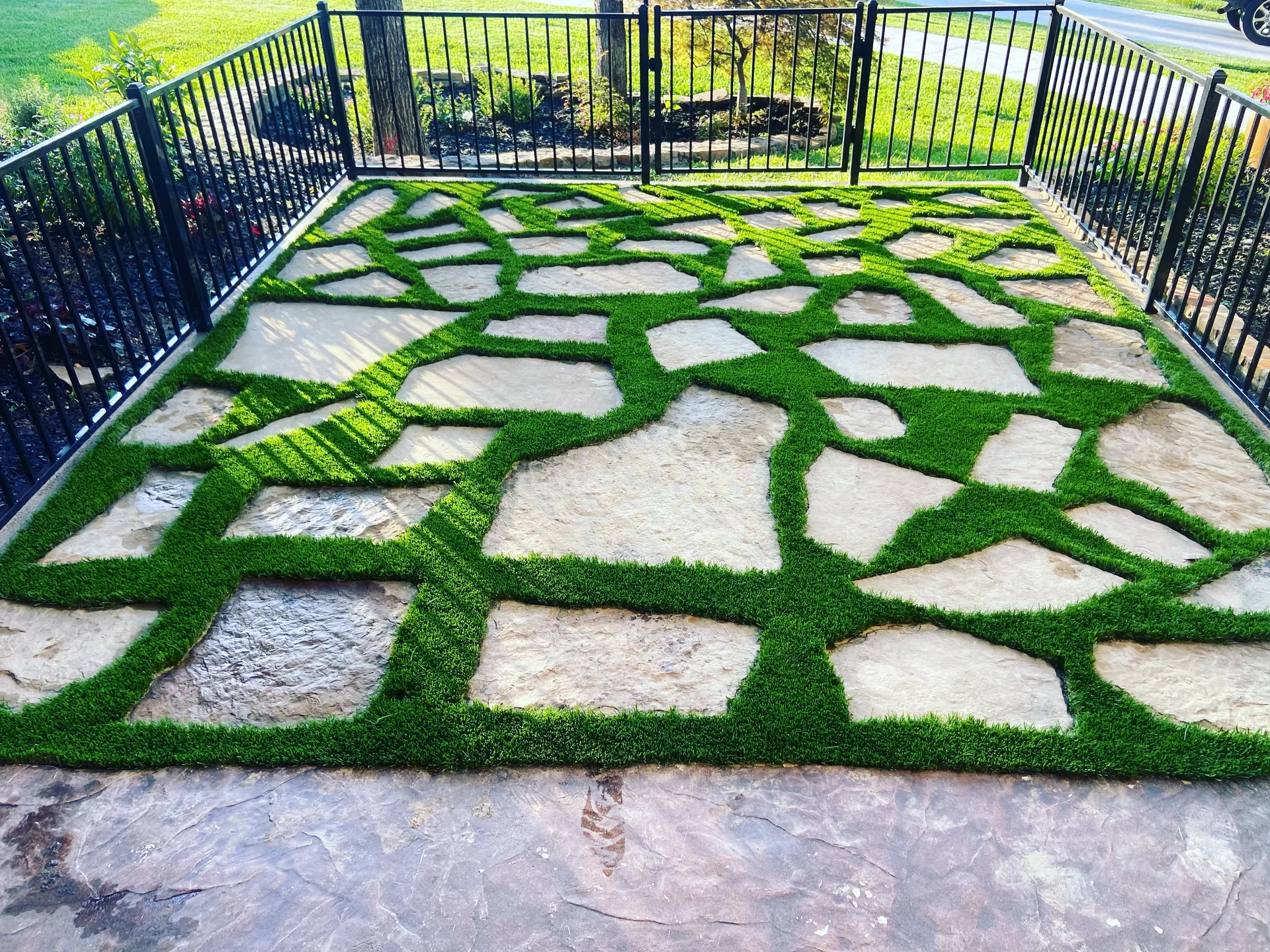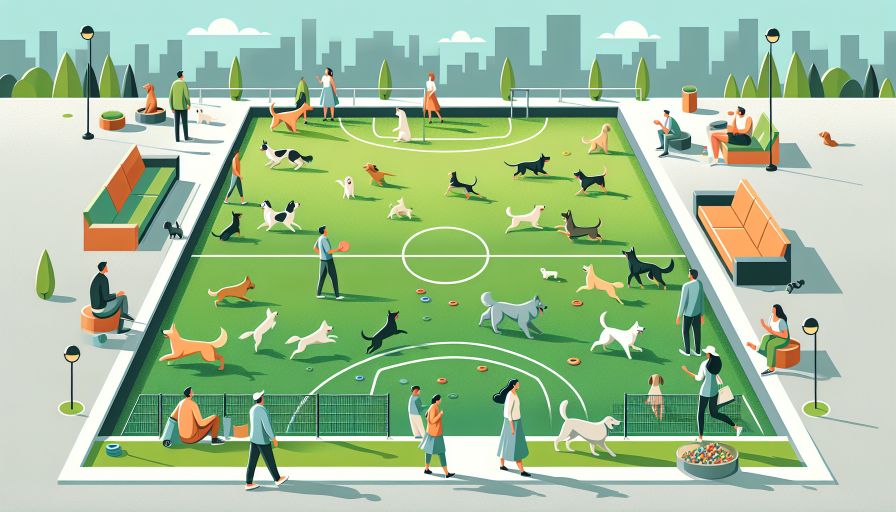
- Introduction to Pet-Friendly Landscaping Solutions
- The Rise of Dog Parks and Pet Areas: Current Trends and Challenges
- The Evolution of Artificial Turf: From Sports Fields to Pet Areas
- Benefits of Artificial Turf for Dog Parks and Pet Areas
- Environmental and Health Considerations
- Installation and Maintenance Best Practices
- Cost Analysis and Economic Impact
- Future Innovations in Artificial Turf and Pet-Friendly Landscaping
Introduction to Pet-Friendly Landscaping Solutions
As pet ownership continues to rise, the need for pet-friendly outdoor spaces has become increasingly apparent. Communities seek solutions that not only accommodate pets but also provide a safe and enjoyable environment for both animals and their owners. This is where pet-friendly landscaping solutions come into play, particularly in the form of dog parks and designated pet areas.
Traditionally, natural grass has been the go-to choice for such spaces. However, maintaining natural grass areas that are frequently used by pets poses several challenges. These include wear and tear from heavy foot traffic, damage from urine, and the need for regular upkeep involving watering, mowing, and fertilizing. These maintenance tasks are not only labor-intensive but can also be environmentally taxing.
In recent years, artificial turf has emerged as a viable alternative to natural grass. Originally designed for sports fields and commercial landscaping, advances in technology have made artificial turf a practical solution for pet areas as well.
Artificial turf offers a range of benefits that cater specifically to the needs of pet-friendly spaces. It addresses common issues associated with natural grass, such as durability, cleanliness, and overall usability. Moreover, it provides a consistent and aesthetically pleasing surface, regardless of weather conditions and usage levels.
By adopting artificial turf, communities can create dog parks and pet areas that are both functional and attractive. This shift not only improves the user experience but also reduces the ongoing maintenance and environmental impact associated with natural grass.
In summary, the introduction of artificial turf in pet-friendly landscaping solutions marks a significant advancement. It enables the creation of better and more sustainable outdoor spaces for pets, meeting the demands of modern urban living and supporting the well-being of our furry companions.
The Rise of Dog Parks and Pet Areas: Current Trends and Challenges
Over the past decade, there has been a significant increase in the number of dog parks and pet-friendly areas being developed across urban and suburban landscapes. According to the Trust for Public Land, U.S. cities have seen a nearly 80% rise in the number of dog parks from 2009 to 2019. This rise is largely driven by the growing number of pet owners who seek communal spaces where their dogs can exercise and socialize safely.
The demand for dog parks is also influenced by the increasing awareness of pets’ physical and mental health needs. Studies, such as those from the American Veterinary Medical Association (AVMA), indicate that regular exercise and social interaction contribute to a pet’s overall well-being. These parks not only offer a controlled environment for physical activity but also help foster community among pet owners.
Current Trends
Several key trends are shaping the design and use of dog parks and pet areas:
- Urbanization: With more people living in urban areas, there’s a need for well-maintained, accessible green spaces for pets.
- Innovative Design: Modern dog parks feature varied terrain, agility equipment, and designated zones for different dog sizes.
- Sustainability: Eco-friendly materials and maintenance practices are becoming more common, aligning with broader environmental goals.
- Safety Measures: Providing safe, hygienic environments has become a priority, with features like clean water stations and waste disposal options.
Challenges
Despite the growth and innovation in dog park development, there are several challenges that municipalities and park designers face:
- Wear and Tear: High foot traffic from both pets and humans can quickly degrade natural grass, leading to muddy, uneven surfaces.
- Maintenance Costs: Regular upkeep of natural grass areas is costly and labor-intensive, requiring frequent mowing, watering, and replanting.
- Sanitation: Maintaining cleanliness to prevent the spread of diseases and parasites remains a significant issue, especially in heavily used parks.
- Space Limitations: In urban settings, the availability of large, open spaces can be limited, making it challenging to create expansive dog parks.
Addressing these challenges while meeting the needs of both pets and their owners is crucial for the continued success and expansion of dog parks and pet areas. This is where innovative solutions, such as artificial turf, can play a transformative role.
The Evolution of Artificial Turf: From Sports Fields to Pet Areas
The evolution of artificial turf has been a significant journey, leading to its current applications in pet areas and dog parks. Initially developed for use in sports fields in the 1960s, synthetic turf has undergone substantial improvements in materials and design, enhancing both its appearance and functionality. The transition from sports fields to residential and commercial landscaping has been particularly noteworthy, driven by a demand for low-maintenance, aesthetically pleasing, and durable ground cover solutions.
The primary advancements in artificial turf have centered around material composition and structural design. Early versions of synthetic grass were made from nylon, which, while durable, often resulted in a hard surface that was unsuitable for pets. Modern artificial turf, however, is typically manufactured using polyethylene or polypropylene. These materials are softer underfoot, reducing the risk of injuries while maintaining resilience and durability.
Additionally, the advancement in backing materials has been crucial. Traditional turfs had solid, impermeable backings, which could lead to water accumulation and subsequent odor issues in pet areas. Contemporary artificial turfs often feature perforated backings, allowing for superior drainage and mitigating these concerns.
The introduction of infill materials is another critical innovation in artificial turf technology. Infill, which can be composed of sand, rubber, or other substances, is distributed between the blades of artificial grass. This component enhances the stability and performance of the turf, making it more comfortable for pets to walk and play on. Moreover, infills can help maintain a consistent texture and prevent the turf from becoming matted down over time.
The following table outlines some key differences between early artificial turf and modern turf designed specifically for pet areas:
| Feature | Early Artificial Turf | Modern Pet-Friendly Turf |
|---|---|---|
| Material | Nylon | Polyethylene/Polypropylene |
| Backing | Solid, impermeable | Perforated, well-draining |
| Infill | Limited or none | Sand, rubber, antimicrobial options |
| Surface Texture | Hard, abrasive | Softer, pet-friendly |
Beyond material advancements, the manufacturing techniques have also improved. One such technique is the tufting process, which has evolved to create denser and more natural-looking turf. This higher density adds to the overall durability and aesthetic appeal, making it more attractive for use in pet areas.
These continuous innovations have expanded the possibilities for artificial turf beyond traditional sports applications, offering practical solutions for creating safe, durable, and appealing pet-friendly environments. The improved comfort, safety, and functionality of modern artificial turf mean that dog parks and pet areas can be designed to cater specifically to the needs of pets, providing a more enjoyable and beneficial experience for both animals and their owners.
Benefits of Artificial Turf for Dog Parks and Pet Areas
Artificial turf offers numerous benefits for dog parks and pet areas, making it an increasingly popular solution for pet-friendly landscaping. Below are key advantages of using artificial turf in these environments:
1. Durability and Longevity
Artificial turf is known for its durability and can withstand heavy use by dogs, whether they are running, digging, or playing. Unlike natural grass, which can become patchy and muddy with frequent use, artificial turf maintains its appearance and structural integrity over time. This makes it an ideal choice for high-traffic pet areas.
2. Low Maintenance
One of the standout features of artificial turf is its low maintenance requirements. Traditional grass needs regular mowing, watering, and fertilizing to stay healthy and visually appealing. In contrast, artificial turf requires minimal upkeep—occasional rinsing to remove waste and debris is often sufficient. This results in both time and cost savings for park managers and pet area owners.
3. Safety and Hygiene
Artificial turf is designed to be a safe and hygienic option for pets. Many products are treated with antimicrobial agents that help reduce odors and prevent the growth of bacteria and mold, creating a cleaner play environment for dogs. Additionally, the surface is generally free from pests such as ticks and fleas, which are common in natural grass.
4. Allergy Reduction
Natural grass can trigger allergies in both pets and their owners. Grass pollen, along with common weeds found in natural lawns, can cause discomfort and health issues for allergy sufferers. Artificial turf eliminates these allergens, providing a more comfortable environment for all users of the space.
5. Environmental Benefits
Installing artificial turf can contribute to environmental conservation efforts. Since artificial grass does not require watering, it helps save water—a crucial advantage, especially in drought-prone areas. Additionally, the reduced need for lawn care chemicals such as fertilizers and pesticides means fewer harmful substances entering the environment.
6. Cost-Effectiveness
Despite the initial investment, artificial turf is often more cost-effective in the long run. Reduced maintenance costs, lower water bills, and the longevity of the product contribute to overall savings. Here is a comparison of costs associated with maintaining natural grass versus artificial turf:
| Expense Category | Natural Grass |
|---|---|
| Watering | High |
| Maintenance (mowing, fertilizing) | High |
| Replacement/Repair | Frequent |
| Initial Installation | Lower |
| Long-Term Cost | High |
By weighing these benefits, it’s clear that artificial turf presents several advantages for dog parks and pet areas, driving its growing adoption in these spaces.
Environmental and Health Considerations
When discussing the integration of artificial turf into dog parks and pet areas, understanding the environmental and health considerations is crucial. Artificial turf has a distinct set of implications that need to be examined carefully to make informed decisions.
Environmental Impact
Artificial turf is known for its low water requirements, which is critical in drought-prone regions. According to a study by the Metropolitan Water District of Southern California, natural grass can use up to 55 gallons of water per square foot annually, whereas artificial turf requires substantially less, mainly for occasional cleaning.
Another environmental benefit is the reduction in pesticide and herbicide usage. Maintaining natural grass often involves chemical treatments to prevent pests and weeds, which can lead to runoff and contamination of local water supplies. Artificial turf eliminates the need for these chemicals, thereby minimizing potential negative environmental impacts.
It is also important to consider the end-of-life disposal of artificial turf. Most turf products are made from polyethylene materials, which are not biodegradable. However, advances in recycling technologies are opening up new avenues for reusing and repurposing turf materials, reducing landfill waste. The Synthetic Turf Council has been active in promoting recycling initiatives and proper disposal practices within the industry.
Health Considerations
Health considerations for both pets and humans are equally significant. Artificial turf must be free of harmful chemicals and heavy metals to ensure it doesn’t pose health risks. Studies by institutions like the Environmental Protection Agency (EPA) have focused on evaluating the composition of infill materials (used to make the turf more stable and resilient) to ensure safety.
Heat is a notable concern with artificial turf. Unlike natural grass, artificial turf can absorb and retain more heat, sometimes reaching surface temperatures up to 86°F higher than natural grass. This can make the surface uncomfortable and even unsafe for pets during hot weather. To address this, manufacturers are developing cool-roof options and heat-reflective surfaces that can mitigate these temperature spikes.
Another health aspect is the cleanliness of the turf. Pet areas and dog parks need to address concerns related to bacteria and parasites that can result from pet waste. Modern artificial turfs are designed with antimicrobial properties and improved drainage systems that help in maintaining a cleaner and more hygienic environment. This includes materials with built-in agents to inhibit the growth of bacteria, molds, and fungi, ensuring a safer space for pets and their owners.
Conclusion
While artificial turf presents numerous environmental and health advantages, it is imperative to stay updated with ongoing research and development in these areas. Ensuring proper installation, regular maintenance, and adherence to safety standards can significantly enhance the benefits while mitigating potential downsides.
Installation and Maintenance Best Practices
Effective installation and maintenance practices are crucial for ensuring that artificial turf in dog parks and pet areas provides a safe and durable environment for pets. Adhering to industry standards and guidelines can help optimize the longevity and performance of the turf.
Installation Best Practices
Proper installation starts with site preparation. The area should be cleared of any debris and leveled. A sub-base layer, typically composed of crushed stone or gravel, is then spread to facilitate drainage. This is essential to prevent waterlogging and promote hygiene.
The artificial turf is laid out over the sub-base and secured in place. Seams between turf rolls must be joined using specialized adhesive and seam tape to ensure a seamless appearance and structural integrity. Attention to detail during this process minimizes the risk of seams becoming loose, which can pose tripping hazards.
It is important to incorporate an effective drainage system beneath the turf. This often involves the installation of drainage pipes to channel water away from the area. Pet-friendly areas benefit from an additional layer of infill material, such as silica sand or rubber granules, to improve the surface’s resilience and pet comfort.
Maintenance Best Practices
Routine maintenance is essential to preserve the appearance and functionality of artificial turf in pet areas. One of the primary maintenance tasks is regular cleaning to remove pet waste. Specialized cleaning solutions that neutralize odors and bacteria can help maintain hygiene. Additionally, debris such as leaves and twigs should be cleared regularly to prevent accumulation.
Brushing the artificial turf helps maintain its shape and keeps the infill evenly distributed. This process can be performed using a mechanical brush or a specialized turf rake. Regular brushing also helps restore the fibers’ upright position, which can become flattened over time due to use.
Periodic inspections are necessary to check for any signs of wear or damage, such as loose seams or areas with reduced infill. Addressing these issues promptly can prevent more extensive damage and maintain the safety of the turf. Replenishing infill material as needed ensures the surface remains comfortable for pets and minimizes wear and tear.
Temperature management is another important aspect of artificial turf maintenance, especially in regions with high temperatures. During hot weather, the surface of artificial turf can become significantly warmer than natural grass. Wetting the surface with water can help cool it down and make it more comfortable for pets.
In summary, the successful implementation of artificial turf in dog parks and pet areas hinges on meticulous installation and diligent maintenance. Adhering to best practices not only enhances the functionality and appearance of the turf but also ensures a safe and enjoyable environment for pets.
Cost Analysis and Economic Impact
When considering the implementation of artificial turf in dog parks and pet areas, conducting a thorough cost analysis is crucial. The financial implications encompass various factors such as initial installation costs, ongoing maintenance, and potential savings over time.
Initial Installation Costs
The initial expenditure for installing artificial turf can be substantial. Costs typically range from $5 to $20 per square foot, depending on the quality of the turf, design complexity, and installation requirements. This cost includes materials, labor, and any necessary site preparation, such as removing existing grass or soil conditioning.
Maintenance Costs
One of the key benefits of artificial turf is the reduction in maintenance costs. Traditional grass requires regular watering, mowing, fertilizing, and pest control, which can add up significantly over time. Conversely, artificial turf requires minimal upkeep. Basic maintenance includes occasional rinsing to remove dust and debris and periodic brushing to maintain the blade structure and appearance.
Water Savings
The water savings associated with artificial turf are considerable. Natural grass surfaces demand regular watering to remain healthy, which can be a significant expense, especially in areas prone to drought. A 2015 study by the Synthetic Turf Council estimated that artificial turf saves between 500,000 to 1 million gallons of water per year for every acre of natural grass replaced.
Longevity and Durability
Quality artificial turf products are designed to be durable and long-lasting, typically with a lifespan of 10-15 years. This longevity can lead to long-term cost savings, as the need for periodic reseeding, re-sodding, or replacing damaged grass is eliminated. Moreover, many artificial turf products come with warranties that provide additional financial security.
Economic Impact on Community
Investing in artificial turf for public dog parks and pet areas can have positive economic implications for the community. Attractive, well-maintained parks can increase property values and attract more visitors, boosting local business revenue. Additionally, these spaces can help reduce municipal expenses related to park maintenance and water usage.
Return on Investment (ROI)
Evaluating the return on investment (ROI) for artificial turf involves analyzing both direct and indirect financial benefits. Direct savings stem from reduced maintenance and water costs, while indirect benefits include enhanced park usability and community appeal. A detailed ROI analysis typically shows that, despite the higher initial cost, artificial turf can become cost-effective within a few years, particularly in high-use areas.
In conclusion, the cost analysis and economic impact of artificial turf in dog parks and pet areas reveal a balanced proposition. While initial installation costs are high, the long-term savings and benefits can outweigh the upfront investment, leading to sustainable, low-maintenance pet-friendly spaces.
Future Innovations in Artificial Turf and Pet-Friendly Landscaping
The landscape of artificial turf technology is continually evolving, with future innovations poised to further transform pet-friendly environments. These developments aim to address ongoing challenges, optimize user experience, and enhance the overall durability and functionality of the turf. Key areas of progress include material advancements, smart technology integration, and sustainable production methods.
Material Advancements
Advancements in material technology are central to the future of artificial turf. The development of new, more resilient fibers and infill options aims to improve turf performance and longevity. Enhanced UV resistance is one such innovation, protecting the turf from degradation due to prolonged sun exposure. Additionally, antimicrobial treatments are being integrated to reduce the buildup of bacteria, ensuring a cleaner and safer play area for pets.
Smart Technology Integration
Smart technology is increasingly being incorporated into artificial turf solutions. Sensors embedded within the turf can monitor various parameters such as surface temperature, moisture levels, and overall wear. This data can then be transmitted to maintenance teams, allowing for proactive and precise upkeep. Moreover, the use of technology can help to automate irrigation systems, ensuring optimal hydration levels and reducing water waste.
Sustainable Production Methods
The push for sustainability is driving innovation in the production of artificial turf. Manufacturers are exploring the use of biodegradable and recyclable materials to reduce the environmental impact of turf production and disposal. Some companies are also focusing on sourcing raw materials from renewable resources, further contributing to the sustainability of artificial turf products.
Innovative Products and Features
Several emerging products and features showcase the potential future directions of artificial turf for pet-friendly landscaping:
- Cushioned Layers: Multi-layered systems that include cushioned layers can offer enhanced impact absorption, making the surface more comfortable and safer for pets.
- Cooling Technologies: Innovative infills and surface coatings designed to reflect and dissipate heat can significantly reduce surface temperatures, providing a more pet-friendly environment.
- Customization Options: Advances in manufacturing allow for greater customization in terms of color, texture, and pile height, enabling turf solutions tailored to specific needs and preferences.
Table: Key Innovations in Artificial Turf
| Innovation | Benefits |
|---|---|
| Enhanced UV Resistance | Longer lifespan, reduced fading |
| Antimicrobial Treatments | Improved hygiene, reduced odor |
| Embedded Sensors | Real-time monitoring, efficient maintenance |
| Recyclable Materials | Environmental sustainability, reduced waste |
| Cooling Technologies | Lower surface temperatures, increased comfort |
As these innovations continue to develop, the potential for artificial turf to revolutionize pet-friendly landscaping will only grow. The ongoing focus on advancing materials, incorporating smart technologies, and enhancing sustainability will ensure that artificial turf remains a leading solution for creating safe, comfortable, and environmentally friendly pet areas.
